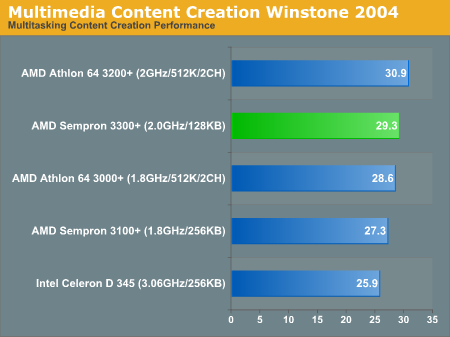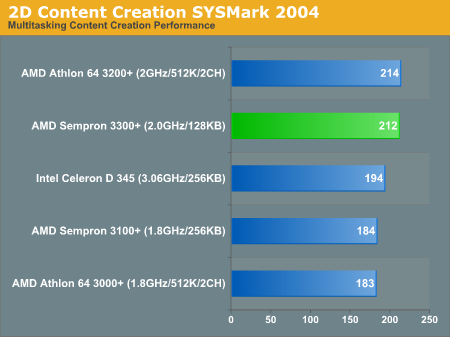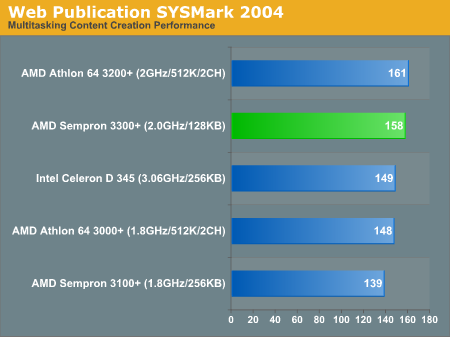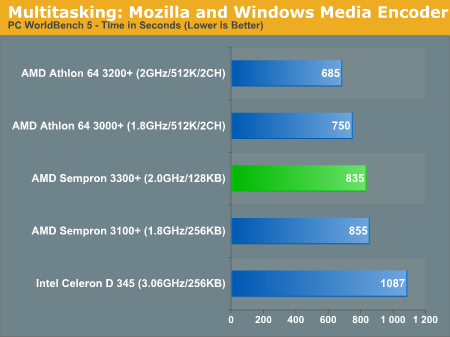AMD's Sempron 3300+: 90nm Budget Computing
by Anand Lal Shimpi on April 18, 2005 2:10 AM EST- Posted in
- CPUs
Multitasking Content Creation
MCC Winstone 2004
Multimedia Content Creation Winstone 2004 tests the following applications in various usage scenarios:
- Adobe® Photoshop® 7.0.1
- Adobe® Premiere® 6.50
- Macromedia® Director MX 9.0
- Macromedia® Dreamweaver MX 6.1
- Microsoft® Windows MediaTM Encoder 9 Version 9.00.00.2980
- NewTek's LightWave® 3D 7.5b
- SteinbergTM WaveLabTM 4.0f
All chips were tested with Lightwave set to spawn 4 threads.

Once again, we see that in the Winstone tests, AMD's Sempron comes out on top of the Celeron D. This time around, we actually see an advantage of the 3300+ over the 3100+.
ICC SYSMark 2004
The first category that we will deal with is 3D Content Creation. The tests that make up this benchmark are described below:
"The user renders a 3D model to a bitmap using 3ds max 5.1, while preparing web pages in Dreamweaver MX. Then the user renders a 3D animation in a vector graphics format."

Next, we have 2D Content Creation performance:
"The user uses Premiere 6.5 to create a movie from several raw input movie cuts and sound cuts and starts exporting it. While waiting on this operation, the user imports the rendered image into Photoshop 7.01, modifies it and saves the results. Once the movie is assembled, the user edits it and creates special effects using After Effects 5.5."

The Celeron D remains reasonably competitive with the Sempron, but the 3300+ takes the 9% lead.
The Internet Content Creation suite is rounded up with a Web Publishing performance test:
"The user extracts content from an archive using WinZip 8.1. Meanwhile, he uses Flash MX to open the exported 3D vector graphics file. He modifies it by including other pictures and optimizes it for faster animation. The final movie with the special effects is then compressed using Windows Media Encoder 9 series in a format that can be broadcast over broadband Internet. The web site is given the final touches in Dreamweaver MX and the system is scanned by VirusScan 7.0."

Mozilla + Media Encoder

The Celeron D performed horribly in the Mozilla test, so adding Media Encoder to the mix doesn't really help anything.










53 Comments
View All Comments
snorre - Friday, June 24, 2005 - link
It seems like AMD also has enabled 64-bit support in this CPU:http://finance.messages.yahoo.com/bbs?.mm=FN&a...
Even better value then I guess.
snorre - Friday, June 24, 2005 - link
Tbuch - Sunday, June 5, 2005 - link
In a time where the Processors are named with a lot of Letter addition Anandtech (and others) must be very caryfully to use these letters. You have been using a Intel 915P Motherboard which is a Socket 775 bord - therefor the Celeron processor you have tested must be a Celeron D 345J (with a"J" addition) and not "only" a 345. Am I right?johnsonx - Friday, April 22, 2005 - link
Interesting... the board's BIOS claims Cool'n'quiet support, and I loaded the latest processor driver from AMD that claims Cool'n'Quiet support for Sempron (same one I use on my own A64 2800+), but I couldn't get the Cool'n'Quiet/PowerNow dashboard demo to run (claimed no supported processor), nor could I see any other sign that it was working, like a low processor speed report in System Properties.a mystery...
(ok, so this is a bit off topic, but at least we are still talking about Semprons)
Rand - Friday, April 22, 2005 - link
I built a system around a Sempron 2600+ (S754) a few weeks ago, Cool n' Quiet worked fine on the MSI K8T Neo-FSR.Stock VCore is 1.4V, it dropped to 1.0V and 1GHz at minimum.
johnsonx - Wednesday, April 20, 2005 - link
#47 - you may or may not be right that only 1.6Ghz semprons don't have CnQ support, but it isn't because of an 8x multiplier limitation. My A64 2800+ drops to 989Mhz on CnQ (I'm guessing that's actually supposed to be 1.0Ghz, but my mainboard's clock is a touch low). That implies a 5x multiplier. Either way, it's clear a 1.8Ghz CPU can drop to 1.0Ghz, so why can't a 1.6Ghz one do it?It'd be nice if AMD would make this clear somewhere - if CnQ is a desireable feature, then why hide which CPU's have it and which don't?
(actually disabling it on ANY cpu is stupid in the first place, but again, AMD doesn't check with me on what I think is stupid)
Oh, BTW, to answer your other question, CnQ drops my A64 2800+ to 1.0v, and as far as I can recall the Sempron 2600+ runs at 1.4v. I'll look when I setup one of them later today (they're in boxes in the customer's office now).
Visual - Wednesday, April 20, 2005 - link
in regards to CnQ on the semprons - it is available to all semprons except the 1.6GHz models, as they are already at 8x multi by default (and CnQ lowers the multi, but it cant get any lower than 8x)I wanna know if CnQ lowers the voltages and by how much.. and if the 1.6GHz semprons come at the lower voltages by default or they are at 1.4v too... but yeah, this is quite out of the topic here. sorry.
Andyvan - Tuesday, April 19, 2005 - link
I'm curious about the tests in which the Sempron out-performed the Athlon 64 3200. Both were running at the same clock speed, and the Sempron has 1/4 the cache.Is this due to SSE3 support?
-- Andyvan
Jep4444 - Tuesday, April 19, 2005 - link
the XP 3200+ has been discontinued for quite some time but the A64 2800+ is still in production hence why its a better comparisonRav3n - Tuesday, April 19, 2005 - link
I would like to have seen a comparison with the Athlon XP 3200+ as well... even though that is just adding yet an additional platform.